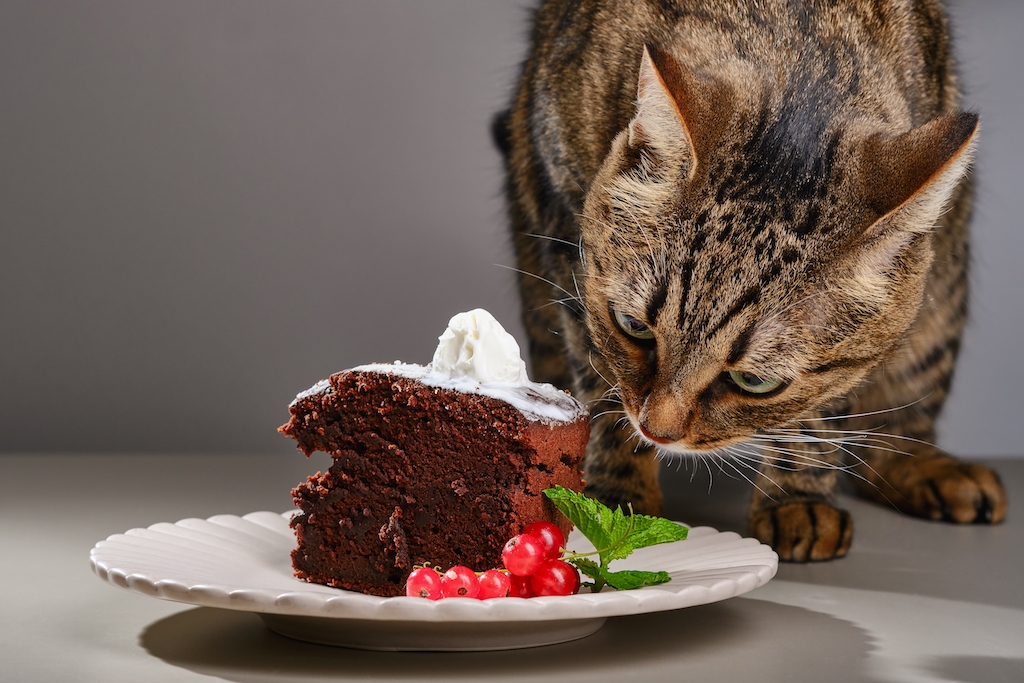
Ingestion of chocolate can be a deadly mistake for dogs and cats. Chocolate (cacao) contains the substances caffeine and theobromine. These substances can have detrimental effects on the GI system, central nervous system, heart, and kidneys of pets. In dogs and cats the ‘half-life’ (length of time it takes for 50% of the substance to break down in the body) for theobromine is over 17 hours. This means that after 17 hours, half of the theobromine ingested is still in their systems. Humans can metabolize caffeine and theobromine more efficiently than pets can, which is why chocolate is not toxic to humans.
How much chocolate is considered toxic?
 No amount of chocolate is safe for an animal to ingest. The effects of chocolate consumption in pets depends on type of chocolate, quantity consumed, and the size (body weight) of the pet. Some types of chocolate contain higher amounts of caffeine and theobromine.
No amount of chocolate is safe for an animal to ingest. The effects of chocolate consumption in pets depends on type of chocolate, quantity consumed, and the size (body weight) of the pet. Some types of chocolate contain higher amounts of caffeine and theobromine.
Reported combined caffeine & theobromine content in different chocolates:
- Dry cocoa powder contains 800 mg/oz
- Unsweetened baker’s chocolate contains 450 mg/oz
- Cocoa Bean hulls (mulch) contains 255 mg/oz
- Semisweet dark chocolate contains 150-160 mg/oz
- Milk Chocolate contains 64 mg/oz
- White chocolate contains an insignificant amount.
The most toxic, cocoa or baker’s chocolate, causes a life-threatening emergency when ingested. The moderately toxic dark chocolates can lead to hospitalization and serious illness in pets when amounts as small as one-tenth of an ounce per pound of body weight are consumed. Even pets that devour less than a half ounce of milk chocolate per pound of body weight are at risk of developing clinical signs.
Online chocolate toxicity calculator can be helpful for pet owners and veterinarians to calculate the potential toxicity of chocolate ingestion.
https://www.petmd.com/dog/chocolate-toxicity
Symptoms of Chocolate Ingestion
Clinical signs of chocolate toxicosis usually occur within 6–12 hours of ingestion.
Initial signs may include:
- Increased thirst
- Vomiting
- Diarrhea
- Restlessness
Signs may progress to:
- Hyperactivity
- Increased urination
- Incoordination or trouble walking
- Fever
- Twitches & tremors
- Rigidity & seizures
- Racing heart progressing to abnormal rhythms
 Treatment of Chocolate Toxicity
Treatment of Chocolate Toxicity
If you suspect your pet has ingested chocolate, you should immediately contact your veterinarian.
If ingestion has occurred within the past 2 hours, the first step is to recover as much chocolate from the patient as possible by inducing vomiting. For many patients, removing the undigested chocolate converts the toxicity from a life-threatening poisoning to just an upset stomach that is easily managed. Absorbents, such as activated charcoal, are administered by mouth to bind the chocolate and prevent absorption of theobromine and caffeine through the gut. The patient may be administered SQ fluids to help flush the system. Pets may be treated on an out patient basis if minor quantities of chocolate have been ingested and treatment is started before clinical signs develop.
If a pet has consumed larger quantities of chocolate, has developed clinical symptoms, or treatment has been delayed then hospitalization may be required. Hospitalized patients receive IV fluids to help flush the kidneys and frequent trips out to go potty are needed to prevent re-absorption of the toxins. Laboratory blood testing may be required to monitor the kidneys. ECG will be used to monitor the heart for changes in rate and rhythm. A variety of medications are used to help treat symptoms such as seizures and arrythmias. Patients may need intensive care for 24 to 48 hours.
Prognosis
The prognosis after chocolate ingestion can be variable depending on the type and quantity of chocolate consumed, and the timing of treatment.
The prognosis is favorable if decontamination, including induction of vomiting and administration of activated charcoal occurs within 2 hours of ingestion and before clinical signs began, the prognosis is favorable. Patients that receive prompt treatment may be treated as outpatients and their symptoms may not progress beyond mild GI upset.
If treatment is delayed past 4 hours of ingestion, and mild clinical signs have started, the pet will need to be hospitalized for 12 to 36 hours for monitoring and supportive care. Pets that have developed symptoms of toxicity have a more guarded prognosis. If symptoms progress to seizures and cardiac arrhythmias the prognosis is poor, and the toxicity may be fatal.
In the days following chocolate ingestion, patients should be monitored carefully. The high fat content of chocolate products may trigger secondary pancreatitis in some patients.






Recent Comments